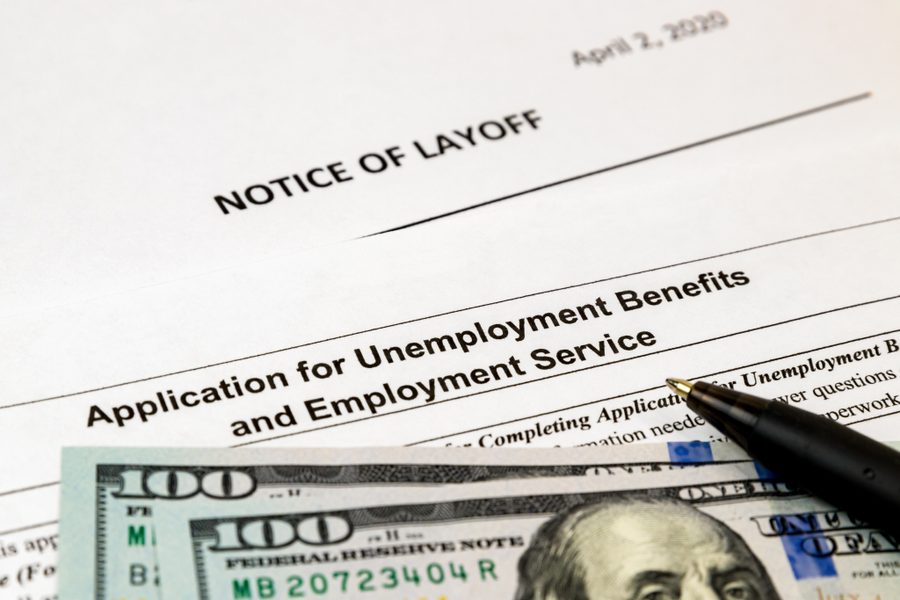One Way to Boost Workers and the Labor Movement? Give Unions Power Over Unemployment Insurance.
A reform from Belgium in the early 1900s would both increase unemployment insurance benefits and decrease the cost of labor organizing. It’s time for the U.S. to embrace it.
Francisco Diez

Despite keeping tens of millions of Americans afloat during the pandemic, expanded unemployment insurance (UI) only reached 41% of unemployed workers according to Professor Eliza Forsythe of the University of Illinois’ School of Labor and Employment Relations, and even among those who did receive it, many saw frequent delays and dangerous pauses in benefits. These issues underline the importance of addressing the program’s systemic flaws.
“It took five weeks to get the next round of extended benefits. I was so behind on rent and basic bills, I had to pay late fees that accrued because it took so long. Now I can barely buy food,” said Sharon Corpening, an unemployed worker in Georgia and member of Unemployed Action, a grassroots campaign run through The Center for Popular Democracy (where I work).
As pressure builds to reform the program for the first time in decades, one policy change could both dramatically improve benefit access for workers like Corpening and give a much-needed boost to the labor movement: Let unions help run the UI system.
Unemployment insurance, if administered, managed or distributed by unions, could unleash a wave of union growth and dramatically improve access to benefits for millions of workers. Commonly called the “Ghent” system, after the city in Belgium where it was first developed as a form of union-led mutual aid in the early 1900s, these policies increase the expected benefits of unemployment insurance for workers and decrease the cost of organizing. The pandemic exposed the cracks in the U.S. unemployment system — and how desperately we need bold, new ideas like this.
At least two legislative proposals to expand access to UI — one state-level effort in Maine and one coming out of the House of Representatives’ Ways and Means Committee — would, if enacted, begin to bring organized labor into the system and plant the seeds of an American Ghent system.
UI currently leaves many workers uncovered, such as undocumented immigrants, unpaid caretakers and graduating students (re)entering the workforce. Most states’ weekly benefits are too low and the benefit periods too short to protect workers from crisis, whether it’s a financial downturn or a pandemic. The average benefit amount replaces about 40% of pre-layoff wages and some states like Florida provide just 12 weeks. Plus, benefits currently depend on “experience rating”: a funding mechanism that rewards employers who challenge employee unemployment claims with lower taxes.
Meanwhile, the state-federal structure helps perpetuate racial disparities. States with higher relative Black populations have less generous benefits and more barriers to access those benefits, even though Black workers suffer twice the unemployment rate of their white counterparts.
Those barriers, like limited benefits for low-wage workers and racist fraud detection systems, contribute to costly delays for countless workers of color, often leading to food insecurity and housing instability.
The CARES Act and subsequent relief packages patched up some of the biggest holes in UI, supplementing and extending inadequate state benefit amounts, and covering independent contractors. Still, these patches did not address access limitations or the fundamental flaws of UI’s design.
To increase access to unemployment benefits and build worker power, future reforms should include a benefits navigator program and government subsidized, union-led wage replacement funds. The federal government could implement these programs or states could lead on their own. Together, these programs would help establish an American Ghent system.
The impacts of these programs — both the benefits navigators and the union-led funds — could transform labor relations in America. Union density in countries with Ghent programs, such as Finland and Belgium, hovers 20 percentage points higher on average above those without them. As Dylan Matthews writes at Vox, the Ghent system “is a key part of how Sweden, Denmark, Finland, and Belgium have achieved the highest union membership rates in the developed world.”
Here’s what it would look like to receive unemployment benefits under a navigator system: If you were a non-union worker, you could head to an office led by a coalition of unions and community organizations where you would talk to a navigator about your case. They would help you file the paperwork, ensure you quickly received your benefits and help advocate on your behalf. They might connect you to job opportunities and provide support for you as you reentered employment.
This may sound familiar. The Affordable Care Act set up a benefits navigator program that successfully increased health insurance enrollment. In 2015, the navigators helped increase enrollment from 84.9% to 93.1% among low-income Americans, with larger gains among low-income Blacks and Latinos.
In a UI benefits navigator program, federal or state governments would provide grants to unions and community organizations to hire navigators in order to help unemployed workers receive benefits. As a result, unions would meet and interact with workers right before they enter a new workplace, while helping secure them the benefits they deserve. In the process, it would help tie organized labor to non-unionized unemployed workers.
Navigators can boost workers’ benefits by expanding access to UI. Union workers are more than twice as likely to apply and receive benefits than non-union workers. Moreover, gaps in unemployment benefit access across racial groups drop from 32 percent to 9 percent while disparities across education levels largely disappear among union workers. Navigator programs would help expand these advantages to nonunion workers as well.
More expansive positive effects would come from instituting government-backed, union-led wage replacement funds in addition to a navigator program.
Under a full Ghent system, here’s how it would work: If you’re a non-union worker, you would be provided the basics of the navigator system described above, but would also get an entirely new set of benefits. For example, the union could provide a benefit to supplement your regular government UI benefit so that your total benefits could equal 90%, for instance, of your pre-layoff earnings. Plus, the union office could connect you to job retraining programs to help keep your skills sharp or even shift your career. If you were a union member, you could pay to keep your membership and you might receive extra benefits or services. For example, your wage replacement benefit might be slightly higher if you were a union member.
In the United States, some workplaces organized by the United Auto Workers have generous supplemental unemployment benefits that members pay into and use when they become unemployed so that their total UI benefits better match their pre-layoff wages. A Ghent system would make similar programs universal, and provide greater governmental support. In Denmark, for example, participating in union-run UI remains technically optional, but about 85% of unemployed workers receive benefits, which is among the highest in industrialized countries.
The wage replacement funds would be owned and administered by unions but heavily subsidized by the government, and would either supplement or replace the existing UI system to better match pre-existing wages. The funds wouldn’t discriminate, would be voluntary, and would likely lead to high rates of participation in the program.
By providing wage replacement funds, unions could give non-union workers easier access to much-needed benefits in times of crisis. Additionally, they would provide a clear incentive for these workers to join a union. State governments could set up the funds through new taxes like small employee-side payroll tax. (Currently, almost all unemployment insurance benefits are financed by employer payroll taxes.) They could also allow labor organizations to use these funds to provide additional benefits like job training.
Such programs would almost assuredly be very popular. One recent survey from the Washington Center for Equitable Growth showed that union-led benefit funds and job training opportunities were some of the most popular labor law reform proposals. The workers surveyed also indicated they would be more likely to join a union if the union provided those benefits. Another survey from Data for Progress showed overwhelming support for benefits navigators.
These policies are not a panacea. Wage replacement funds would pose an administrative challenge in states with low-union density. Moreover, they cannot replace the militant organizing needed to revive the labor movement in the United States. Labor membership matters, but so does using labor power effectively through tactics like striking. Ghent-style policies do not aim to replace organizing but rather facilitate it by decreasing some of the costs and increasing the immediate benefits of doing so. They increase the access and contacts workers have to labor organizations, and vice-versa.
While unions, grassroots groups and advocacy organizations fight for continued unemployment relief, many of them are pushing for an overhaul of UI. In mid-April, Sens. Ron Wyden (D-Ore.) and Michael Bennet (D-Colo.) released a discussion draft of a bill that would begin to address many of the flaws in the current UI system through federal standards to expand coverage, minimum benefit standards, and automatic stabilizers. At the end of May, the Biden administration included similar reforms in its 2022 budget draft.
Although these proposals don’t include any Ghent-inspired policies, other officials have put forward plans that would expand UI program access and facilitate labor organizing.
In late April, Rep. Richard Neal (D-Mass.), Chairman of the House Ways and Means Committee, unveiled legislation called the Worker Information Network that includes a benefits navigator program for UI as well as paid leave and childcare. However, the plan allows for a variety of non-profit organizations to receive funding, not just labor organizations. Due to their budgetary nature, federal UI reforms, including Ghent policies, could likely pass through the Senate’s reconciliation process which would require just 50 votes in the Democratic-controlled chamber. On the state level, a coalition of labor and community organizations, including the Maine AFL-CIO, is championing UI reform that includes UI benefit navigators that could be deployed by either community or labor organizations.
The Center for Popular Democracy’s Unemployed Action project members and many of its local partners developed a federal #FixUI platform that includes not just navigators, but greater union and community organization involvement in training and boosting benefits. The Center for American Progress’ David Madland has proposed both UI navigators and a Ghent system. While no international or national labor union is currently campaigning for a full Ghent system, some labor leaders, like David Rolf, president of SEIU 775 in Seattle, have expressed support for Ghent-style policies.
Sharon Corpening, the worker in Georgia, said, “This pandemic widened the fissures that were already there. To patch them, we’re missing the voice of workers who have to receive the benefits, who are really not making it, even in the best of economic circumstances. Unemployment is broken beyond repair without a serious overhaul.”
The UI system’s weaknesses are now more apparent than at any point since the Great Recession. The best chance to reform unemployment insurance in decades is here. And with it, we have the chance to implement policies that could help give both the labor movement and workers — organized and not yet organized — the boost they badly need.
The ideas put forward in this article represent the views of the author alone and not their employer.
Francisco Diez is an organizer from Philadelphia and the Worker Justice Policy Advocate at The Center for Popular Democracy.




